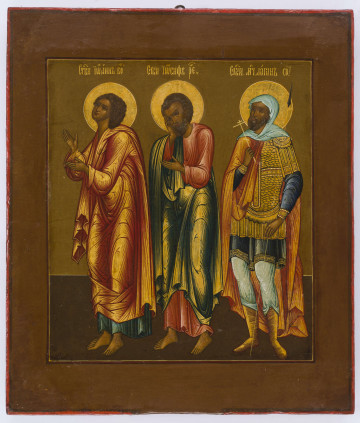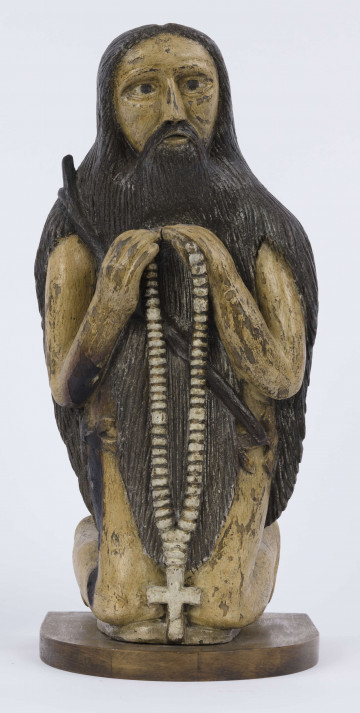
Ascension / Saints John, Joseph and Longinus
1801 — 1900
National Museum in Lublin
Part of the collection: Folk Art of the Lublin Region (17th–1st half of the 20th c.)
The patron saints played a significant role in traditional religiosity. They were attributed, like Jesus and Mary (see E/419/ML), with the power of mediation between man and God. They were asked to help in difficult family matters, illness or natural disasters. Each was recognizable by props - attributes, often associated with a life or form of martyrdom (see: E/6353/ML). The saints known to the population were numerous. The popularity of hagiographical literature contributed to this. Legends based on plots from their lives often had little in common with their originals, and popular imagination was eager to create saints who did not exist in church records. However, St Joseph was not one of them.
The spouse of Mary of Nazareth, traditionally called her Bridegroom, and protector of the Holy Family, he was widely known. He was considered the patron saint of marriages and families, of orphans, and of working people, especially carpenters, woodcutters, and craftsmen. By the supposition that he ended his life in the presence of Christ and the Blessed Virgin, he is considered the patron of a good death.
Iconography, including folklore, used to depict St. Joseph as an old man. He appears in representations of the Holy Family with Mary and Jesus (see E/16049/ML), in scenes in the crib of Bethlehem and the prostration of the Wise Men from the East or the flight into Egypt, in images of St. Anne of Samothrace (see E/15669/ML) or with the infant Jesus, whom he holds in his arms and holds a lily in his hand (see E/16844/ML). His attributes also include carpentry tools: saw, axe, carpenter's workshop, and a water-bucket, wanderer's stick, flowering wand (Jesse), porridge bowl, lamp, vine.
His commemoration was incorporated into the liturgy in Jerusalem in the 5th century. In the West it was adopted in the 8th century. In Poland, especially in Krakow, the 19th of March was celebrated as early as the turn of the 11th and 12th centuries. The feast, although it fell during Lent, was joyful, and the obligation of abstinence from meat was lifted. On this one day of preparation for Easter, one could feast and "not keep the fast". This is still the case today.
Author / creator
Dimensions
cały obiekt: height: 115,5 cm, width: 47,5 cm
Object type
sculpture
Technique
polychromy
Material
wood, paint
Creation time / dating
Creation / finding place
Owner
The National Museum in Lublin
Identification number
Location / status

1801 — 1900
National Museum in Lublin

1894 — 1930
National Museum in Lublin

1801 — 1900
National Museum in Lublin
DISCOVER this TOPIC
Castle Museum in Łańcut
DISCOVER this PATH
Educational path